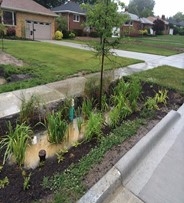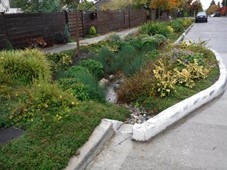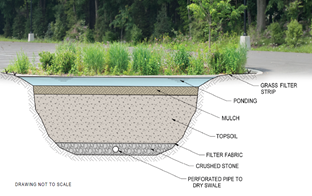
Rain gardens are small depressions in the ground (from a few inches to a few feet deep depending on soil conditions), that receives rainwater from hardscapes and holds the water to seep back into the ground. Rain gardens are often planted with native plants that can tolerate wet feet for part of the year but are just as happy when the dry, drought like condition occurs. Rain gardens are relatively inexpensive to build, and are sized according to your hardscape; the more hardscape, the larger the rain garden. Most home sized rain gardens cover less than 500 square feet, so they are easy to maintain. Rain gardens are very effective at controlling runoff. One neighborhood in Burnsville, Minnesota installed 17 rain gardens at 14 homes and runoff was reduced from almost 36,000 gallons to less than 1,000!
Community parks can serve as a rainwater retention pond during the wet season. This will help the community avoid flooding, but the park itself will be unusable when the area is full of water. Curbline planting areas, front yards, side yards, even street dividers can serve as bioretention cells. A complimentary solution would be for homeowners to consider building their own rain gardens, and collect some of the water that would normally be lost to rivers and lakes or to the park retention pond. As the gardens consist mainly of native plants, the homeowner and community will benefit from less water use, beautiful yards, and everyone will benefit by replenishing the groundwater aquifers that we rely upon. Of course, rain gardens can be built anywhere…how about your yard?
